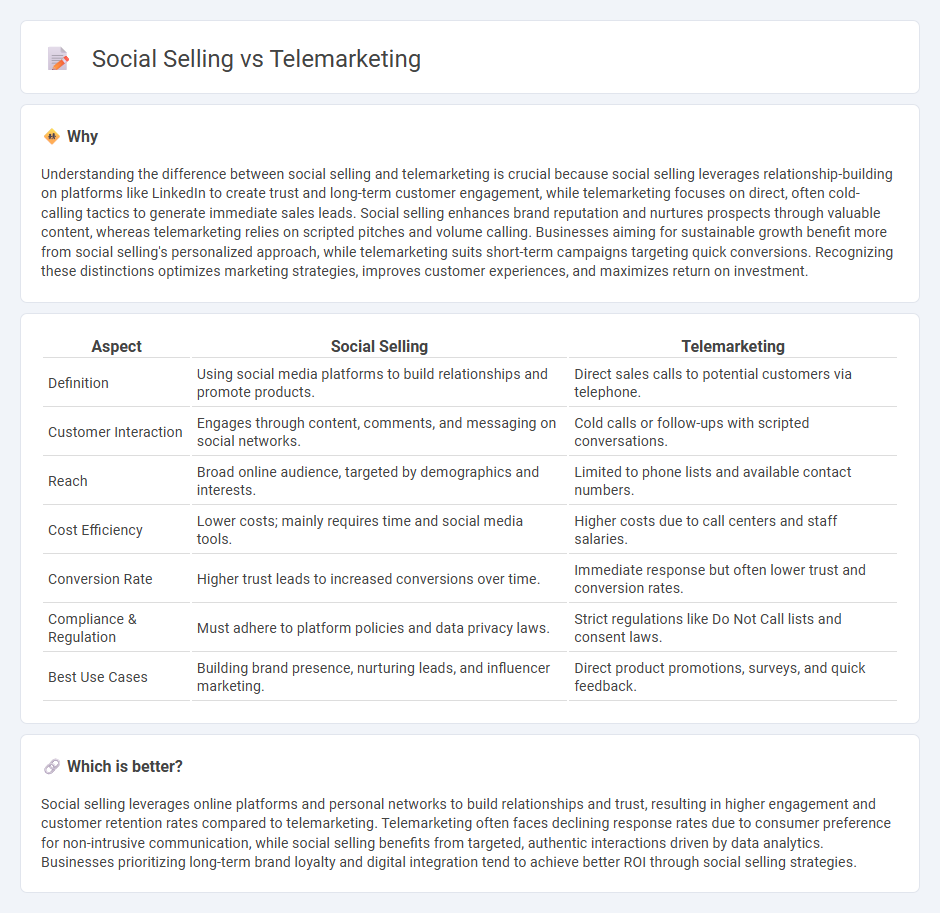
Social selling leverages social media platforms to build relationships and engage customers through personalized content, fostering trust and brand loyalty. Telemarketing relies on direct phone calls to reach potential buyers, focusing on immediate communication and sales conversion. Discover how these strategies can be optimized for your business growth.
Why it is important
Understanding the difference between social selling and telemarketing is crucial because social selling leverages relationship-building on platforms like LinkedIn to create trust and long-term customer engagement, while telemarketing focuses on direct, often cold-calling tactics to generate immediate sales leads. Social selling enhances brand reputation and nurtures prospects through valuable content, whereas telemarketing relies on scripted pitches and volume calling. Businesses aiming for sustainable growth benefit more from social selling's personalized approach, while telemarketing suits short-term campaigns targeting quick conversions. Recognizing these distinctions optimizes marketing strategies, improves customer experiences, and maximizes return on investment.
Comparison Table
| Aspect | Social Selling | Telemarketing |
|---|---|---|
| Definition | Using social media platforms to build relationships and promote products. | Direct sales calls to potential customers via telephone. |
| Customer Interaction | Engages through content, comments, and messaging on social networks. | Cold calls or follow-ups with scripted conversations. |
| Reach | Broad online audience, targeted by demographics and interests. | Limited to phone lists and available contact numbers. |
| Cost Efficiency | Lower costs; mainly requires time and social media tools. | Higher costs due to call centers and staff salaries. |
| Conversion Rate | Higher trust leads to increased conversions over time. | Immediate response but often lower trust and conversion rates. |
| Compliance & Regulation | Must adhere to platform policies and data privacy laws. | Strict regulations like Do Not Call lists and consent laws. |
| Best Use Cases | Building brand presence, nurturing leads, and influencer marketing. | Direct product promotions, surveys, and quick feedback. |
Which is better?
Social selling leverages online platforms and personal networks to build relationships and trust, resulting in higher engagement and customer retention rates compared to telemarketing. Telemarketing often faces declining response rates due to consumer preference for non-intrusive communication, while social selling benefits from targeted, authentic interactions driven by data analytics. Businesses prioritizing long-term brand loyalty and digital integration tend to achieve better ROI through social selling strategies.
Connection
Social selling leverages social media platforms to build relationships and engage potential customers, while telemarketing directly contacts prospects via phone calls to drive sales. Both strategies focus on personalized communication to influence buyer decisions and enhance customer outreach. Integrating social selling insights with telemarketing efforts improves lead qualification and increases conversion rates in commerce.
Key Terms
Lead Generation
Telemarketing actively engages potential leads through direct phone calls, generating immediate responses and qualifying prospects in real-time, which often results in higher conversion rates. Social selling leverages social media platforms and content-driven interactions to build trust and long-term relationships, attracting leads organically and nurturing them through personalized engagement. Explore the distinct strategies and benefits of telemarketing and social selling to optimize your lead generation efforts effectively.
Customer Engagement
Telemarketing relies on direct calls and scripted pitches to engage customers, often resulting in interruptive interactions with limited personalization. Social selling leverages social media platforms to build authentic relationships and provide personalized value, fostering higher engagement and trust over time. Discover how integrating social selling strategies can transform your customer engagement and drive sales growth.
Conversion Rate
Telemarketing conversion rates average around 2-3%, limited by intrusive calls and customer resistance, while social selling achieves higher rates near 5-8% due to personalized engagement and trust-building on platforms like LinkedIn. Data shows social selling also drives longer-term customer relationships and higher lifetime value compared to telemarketing's quick, often one-off sales. Explore detailed strategies and metrics to optimize your sales conversions effectively.
Source and External Links
Telemarketing - Wikipedia - Telemarketing is a direct marketing method where salespeople contact prospective customers via phone, fax, or internet to sell products or services, with major categories including business-to-business and business-to-consumer telemarketing, involving activities like lead generation, sales, and appointment setting.
What Is Telemarketing? Definition, Types, Skills and Roles - Indeed - Telemarketing is direct advertising through phone calls or emails to potential customers, often employed by businesses to increase sales, requiring skills such as product knowledge, empathy, and persuasion.
Telemarketing | Definition & Examples - Lesson - Study.com - Telemarketing is a sales practice involving contacting potential customers by phone to pitch products or services, often using cold calling and targeted contact lists, and is also used for charities and political campaigns.
 dowidth.com
dowidth.com